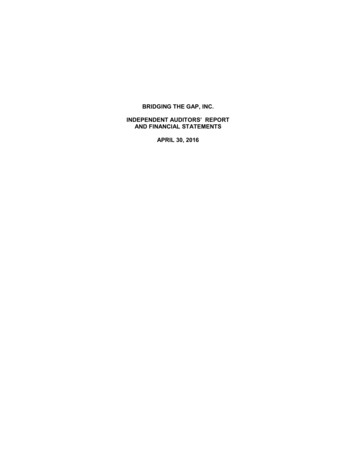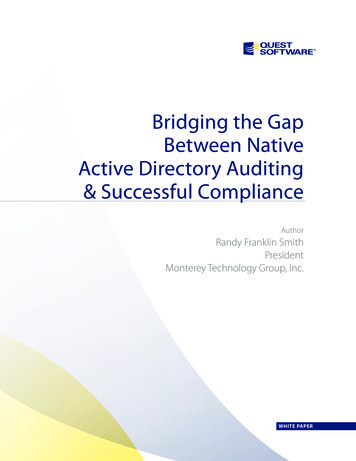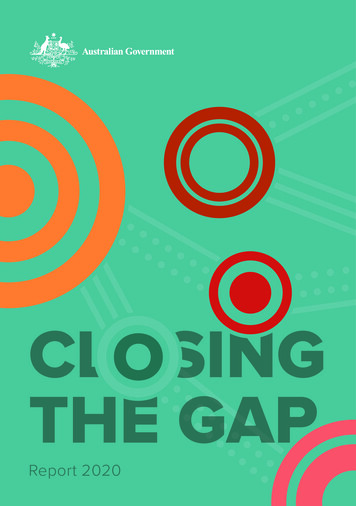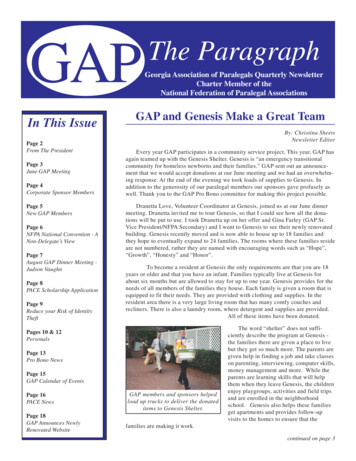
Transcription
BRIDGING THE GAP, INC.INDEPENDENT AUDITORS’ REPORTAND FINANCIAL STATEMENTSAPRIL 30, 2016
BRIDGING THE GAP, INC.APRIL 30, 2016CONTENTSPAGEINDEPENDENT AUDITORS’ REPORT1FINANCIAL STATEMENTSStatement of Financial PositionStatement of ActivitiesStatement of Functional ExpensesStatement of Cash Flows2345NOTES TO FINANCIAL STATEMENTS6-13
INDEPENDENT AUDITORS’ REPORTTo the Board of DirectorsBridging the Gap, Inc.Report on the Financial StatementsWe have audited the accompanying financial statements of Bridging the Gap, Inc. (a nonprofitorganization), which comprise the statement of financial position as of April 30, 2016, and the relatedstatements of activities, functional expenses, and cash flows for the year then ended, and the relatednotes to the financial statements.Management’s Responsibility for the Financial StatementsManagement is responsible for the preparation and fair presentation of these financial statements inaccordance with accounting principles generally accepted in the United States of America; this includesthe design, implementation, and maintenance of internal control relevant to the preparation and fairpresentation of financial statements that are free from material misstatement, whether due to fraud orerror.Auditor’s ResponsibilityOur responsibility is to express an opinion on these financial statements based on our audit. Weconducted our audit in accordance with auditing standards generally accepted in the United States ofAmerica. Those standards require that we plan and perform the audit to obtain reasonable assuranceabout whether the financial statements are free from material misstatement.An audit involves performing procedures to obtain audit evidence about the amounts and disclosures inthe financial statements. The procedures selected depend on the auditor’s judgment, including theassessment of the risks of material misstatement of the financial statements, whether due to fraud or error.In making those risk assessments, the auditor considers internal control relevant to the entity’spreparation and fair presentation of the financial statements in order to design audit procedures that areappropriate in the circumstances, but not for the purpose of expressing an opinion on the effectiveness ofthe entity’s internal control. Accordingly, we express no such opinion. An audit also includes evaluatingthe appropriateness of accounting policies used and the reasonableness of significant accountingestimates made by management, as well as evaluating the overall presentation of the financialstatements.We believe that the audit evidence we have obtained is sufficient and appropriate to provide a basis forour audit opinion.OpinionIn our opinion, the financial statements referred to above present fairly, in all material respects, thefinancial position of Bridging the Gap, Inc. as of April 30, 2016, and the changes in its net assets and itscash flows for the year then ended in accordance with accounting principles generally accepted in theUnited States of America.Kansas City, MOJanuary 25, 20174520 Madison Avenue, Suite G, Kansas City, Missouri 64111 816-531-2822 EmerickCPA.com
BRIDGING THE GAP, INC.STATEMENT OF FINANCIAL POSITIONAPRIL 30, 2016ASSETSCash and cash equivalentsReceivables, including unbilled receivables of 69,773Contributions receivablePrepaid expensesProperty and equipment, netInvestmentsTOTAL ASSETS 315,71587,098102,1771,6001,453,490126,344 2,086,424LIABILITIES AND NET ASSETSLiabilitiesAccounts payableAccrued expensesUnearned incomeNotes payableTotal Liabilities 20,21510,230119,015102,177251,637Net AssetsUnrestrictedLess investment in property and equipmentNet unrestrictedTemporarily restrictedPermanently restrictedTotal Net 834,787TOTAL LIABILITIES AND NET ASSETSSee notes to financial statements.2 2,086,424
BRIDGING THE GAP, INC.STATEMENT OF ACTIVITIESFOR THE YEAR ENDED APRIL 30, 2016UNRESTRICTED NET ASSETSREVENUESGrantsFees for servicesWorkshop incomeMembershipsContributionsSponsorshipsIn-kind donationsInvestment incomeInterest incomeOther Net assets, released from restrictionsTotal RevenuesEXPENSESProgram servicesAdministrativeFundraisingTotal 5,347826,156INCREASE IN UNRESTRICTED NET ASSETSTEMPORARILY RESTRICTED NET ASSETSContributionsNet assets, released from restrictionsDECREASE IN TEMPORARILY RESTRICTED NET ASSETSINCREASE IN NET ASSETSNET ASSETS, BEGINNING OF YEARNET ASSETS, END OF YEARSee notes to financial 65 1,834,787
BRIDGING THE GAP, INC.STATEMENT OF FUNCTIONAL EXPENSESFOR THE YEAR ENDED APRIL 30, 2016SalariesPayroll taxesEmployee benefitsTotal Personnel CostsProfessional servicesTravel and trainingVolunteer appreciation and supportEquipment and technologyRent and utilitiesProgram suppliesOffice and operating suppliesPostage and deliveryAdvertising and promotionsPrinting and visual materialTelephoneInsuranceInterestIn-kind donation of rentMiscellaneousTotal Expenses Before DepreciationProgram 36,245DepreciationTOTAL EXPENSES 712,6182041,30393114509916923,65470,40623,480 659,725 678 71,084See notes to financial 347 594,94944,0003,654801,99824,158 826,156
BRIDGING THE GAP, INC.STATEMENT OF CASH FLOWSFOR THE YEAR ENDED APRIL 30, 2016CASH FLOWS FROM OPERATING ACTIVITIESChange in net assetsAdjustments to reconcile change in net assets to cashflows from operating activitiesDepreciationChanges in operating assets and liabilities:Receivables, netContributions receivableAccounts payableAccrued expensesUnearned incomeNet cash provided by operating activities ASH FLOWS FROM INVESTING ACTIVITIESChange in investmentsNet cash used in investing activities(101,730)(101,730)CASH FLOWS FROM FINANCING ACTIVITIESProceeds from notes payableNet cash provided by financing activities4,9494,949INCREASE IN CASH45,820CASH AND CASH EQUIVALENTS, BEGINNING OF YEAR269,895CASH AND CASH EQUIVALENTS, END OF YEAR 315,715INTEREST PAID See notes to financial statements.54,949
BRIDGING THE GAP, INC.NOTES TO THE FINANCIAL STATEMENTSFOR THE YEAR ENDED APRIL 30, 2016NOTE 1: SUMMARY OF SIGNIFICANT ACCOUNTING POLICIESNature of ActivitiesBridging the Gap, Inc. (the Organization) is a not-for-profit organization that works to make the greaterKansas City region sustainable for the future by encouraging individuals, businesses, institutions,organizations and governments to take action.Grants, Fees for Services Contracts, and ContributionsThe Organization has received certain private and public sector grants, fee for services contracts, andcontributions to fund its community education and action programs.Contract Services (CS) - consists of smaller mission based projects and service contracts, suchas rain barrel workshops or recycling training at area events. Also, our executive director’smission-based activity, such as her service on the City of Kansas City Missouri’s ClimateProtection Steering Committee or the Kansas City Native Plant Initiative, is tracked in thiscategory.EarthWalk (EW) - is an annual regional Earth Day celebration, public education and fundraisingevent held in partnership with area parks departments with support from area businesses,organizations and government agencies. In FY 2015/2016, Earthwalk was held in fall and theleading sponsor was Time Warner Cable, now Charter Communications.Green Business Network (GBN – formerly Environmental Excellence Business NetworkProject) – is a program coordinating networking among business policy-makers andenvironmental personnel at area businesses and governments. This project is supported bycorporate sponsorships, membership dues and event fees. In FY 2015/2016, Bridging The Gapreceived funding from consulting work in partnership with REV, a California-based non- profitwhich engages businesses in writing sustainability plans. Bridging The Gap persuaded the localutility company, Kansas City Power & Light, to convene and fund a Sustainability Circle in KansasCity, with ten local entities involved for 18 months. Bridging The Gap also received funding fromthe Kansas City Industrial Council in FY 2015/2016 for managing their Sustainability Committee.Heartland Tree Alliance (HTA) – is a program to develop a volunteer-based organization toeducate and involve citizens, businesses and governments in community forestry. HTA plants1,000 to 4,000 trees annually in greater Kansas City, with funding from grants and donations.Kansas City Community Recycling Centers (KCDO) – Bridging the Gap, Inc. has contracted tocoordinate three recycling drop-off centers in KCMO, providing staff, volunteer supervision andbroad-based community education on sustainability. This is a long-standing fee for servicecontract with the Solid Waste department of the City of Kansas City, MO.Kansas City WildLands (KCWL) - is a partnership with over 29 organizations to involve citizensin restoring and maintaining remnant ecosystems in the metropolitan region. KCWL engagesvolunteers to restore and maintain approximately 450 acres of remnant (never ploughed) lands ingreater Kansas City, with a diverse funding base including grants, fee for service and privatedonations.6
BRIDGING THE GAP, INC.NOTES TO THE FINANCIAL STATEMENTSFOR THE YEAR ENDED APRIL 30, 2016NOTE 1: SUMMARY OF SIGNIFICANT ACCOUNTING POLICIES (continued)Grants, Fees for Services Contracts, and Contributions (continued)Keep Kansas City Beautiful (KKCB) - is a program to involve businesses, government andcitizens in creating a clean and beautiful community through public education, litter abatementand beautification projects. This project is affiliated with the nation-wide Keep America Beautifulproject. In 2014 a large city contract for litter abatement was cancelled, but Bridging The Gapcontinued a smaller scope of work on litter abatement and beautification with private funding, andmaintained a relationship with Keep America Beautiful. Additional funding was received fromJohnson County Stormwater department to do education and stream clean-ups, and is accountedfor under the KKCB program column.Monarch Butterfly Gardens – this activity was funded for three months in FY 2015/2016 with asubcontract with Burroughs Audubon, a partner non-profit in Kansas City, which successfullysought grant funding from the National Fish & Wildlife Foundation. Bridging The Gap hired abiologist and led the planting of 175 monarch gardens and 5 workshops. The program continuedinto 2016/17.Solid Waste Management District Grant (SWMD)—funding from Missouri’s Solid WasteManagement District, housed at Mid America Regional Council, for work to encouragebusinesses to increase their recycling. More than 60 Missouri businesses are now involved in theprogram.Shadowcliff (SC) - is a retreat center bordering Rocky Mountain National Park above GrandLake, Colorado. A chalet-style mountain lodge built by volunteer labor hosts individuals andgroups in a setting that facilitates sustainability leadership training, community building andconnecting with nature, sometimes led by BTG’s founder, Bob Mann, who lives in nearby Ft.Collins. Shadowcliff’s income and expenses are maintained separately from Bridging The Gap’sbooks, as it is a 509 (a) organization. However, the land and buildings are assets of Bridging TheGap and the value and depreciation of the property are reflected on their financials.Basis of PresentationThe accompanying financial statements have been prepared on the accrual basis of accounting inaccordance with generally accepted accounting principles in the United States of America (GAAP).Revenues, expenses, gains and losses are classified based on the existence or absence of donorimposed restrictions. Accordingly, the net assets are classified and reported as follows:Unrestricted net assets – Net assets that are not subject to any donor-imposed restrictions.Temporarily restricted net assets – Net assets subject to donor-imposed restrictions on their use that maybe met by actions of the Organization or the passage of time.Permanently restricted net assets – Net assets subject to donor-imposed or other legal restrictionsrequiring that the principal be maintained permanently by the Organization. Generally, the donors permitthe Organization to use all or part of the income earned for either general or donor-specified purposes.Cash and Cash EquivalentsFor the purpose of the Statement of Cash Flows, the Organization considers all investments with maturitydates of three months or less to be cash equivalents.7
BRIDGING THE GAP, INC.NOTES TO THE FINANCIAL STATEMENTSFOR THE YEAR ENDED APRIL 30, 2016NOTE 1: SUMMARY OF SIGNIFICANT ACCOUNTING POLICIES (continued)Contributed ServicesA portion of the Organization’s functions and programs are conducted by unpaid volunteers. The value ofthis contributed time is not reflected in the accompanying financial statements since the volunteers’ timedoes not meet the criteria for recognition. Management estimates the fair value of these services to beapproximately 184,000.EquipmentExpenditures for equipment over 1,500 are recorded at cost on the date of acquisition or fair marketvalue on the date of donation. Depreciation is computed by the straight-line method over the estimateduseful lives of the assets.Unearned incomeThe Organization receives grants in advance of program expenditures, the revenues from which aredeferred until the corresponding expenditures are incurred. The grant revenue is recognized based on theamount of actual expenditures.EstimatesThe preparation of financial statements in conformity with GAAP requires management to make estimatesand assumptions that affect certain reported amounts and disclosures. Accordingly, actual results coulddiffer from those estimates.Functional Expense AllocationThe Organization allocates its expenses on a functional basis between its various program andsupporting services. Expenses that can be identified with a specific program or supporting service areallocated directly according to their natural expense classification. Other expenses that are common toseveral functions are allocated based on management’s estimate of usage.Income TaxesThe Organization is exempt from federal income taxes under Section 501(c)(3) of the Internal RevenueCode (IRC) and state law, and contributions to the Organization are tax deductible within the limitationsprescribed by the IRC. The Organization has been classified as a publicly-supported organization whichis not a private foundation under Section 509(a) of the IRC. Among other things, the Organization isexempt from income, Federal Unemployment Tax Act, and state and local real estate taxes.ReceivablesThe Organization considers all receivables to be fully collectible. There is no history of any material baddebts nor any past due amounts. Accordingly, no allowance for credit losses is required. If amountsbecome uncollectible as determined by management review, they will be charged to operations when thatdetermination is made. All receivables are contractually due in less than one year.8
BRIDGING THE GAP, INC.NOTES TO THE FINANCIAL STATEMENTSFOR THE YEAR ENDED APRIL 30, 2016NOTE 1: SUMMARY OF SIGNIFICANT ACCOUNTING POLICIES (continued)Revenue RecognitionThe Organization recognizes revenue from fee for services contracts as the services are provided.Contributions received are recorded as increases in unrestricted, temporarily restricted, or permanentlyrestricted net assets, depending on the existence and/or nature of any donor restrictions. All otherrevenues are recognized as revenue in the period earned. The Organization has elected to showcontributions whose restrictions are met in the same period in which they are received as unrestricted.Subsequent EventsSubsequent events have been evaluated through January 25, 2017, which is the date the financialstatements were available to be issued.NOTE 2: CONTRIBUTIONS RECEIVABLEContributions receivable at April 30, 2016 were as follows:Receivable in less than one yearReceivable in one to five yearsReceivable in more than five yearsTotal contributions receivableLess: discounts to net present value at 5.09%Net contributions receivable 15,00075,00030,000120,00017,823102,177NOTE 3: INVESTMENTSInvestments are held with a community foundation and a brokerage firm and are presented at fair valuebased on market quotes or the stated fair value obtained from the community foundation. They consist ofthe following at April 30, 2016:Money marketMutual fundsEquity poolIntermediate fixed Income poolShort term fixed income poolTotal investments 4,44797,3857,4106,87810,224 126,344The following schedule summarizes the investment income on these investments at April 30, 2016:Interest and dividend incomeRealized gainUnrealized gainTotal investment income 585671,786 2,438NOTE 4: FAIR VALUE MEASUREMENTSGAAP defines fair value and establishes a consistent framework for measuring fair value for certainassets and liabilities. These provisions establish a fair value hierarchy that prioritizes the inputs tovaluation techniques used to measure fair value. The hierarchy gives the highest priority to unadjustedquoted prices in active markets for identical assets or liabilities (level 1 measurements) and the lowestpriority to unobservable inputs (level 3 measurements). An asset’s or liability’s classification within thehierarchy is determined based on the lowest level input that is significant to the fair value measurement.9
BRIDGING THE GAP, INC.NOTES TO THE FINANCIAL STATEMENTSFOR THE YEAR ENDED APRIL 30, 2016NOTE 4: FAIR VALUE MEASUREMENTS (continued)The three levels of the fair value hierarchy are described below:Level 1:Inputs to the valuation methodology are unadjusted quoted prices for identical assets orliabilities in active markets that the Organization has the ability to access.Level 2:Inputs to the valuation methodology include: Quoted prices for similar assets or liabilities in active markets Quoted prices for identical or similar assets or liabilities in inactive markets Inputs other than quoted prices that are observable for the asset or liability Inputs that are derived principally from or corroborated by observable marketdata by correlation or other means.If the asset or liability has a specified (contractual) term, the Level 2 input must beobservable for substantially the full term of the asset or liability.Level 3:Inputs to the valuation methodology are unobservable and significant to the fair valuemeasurement.Investments with broker: The value that is reported by the brokerage firm is based on the market value ofpublicly traded mutual funds.Investments with community foundation: The value that is reported by the community foundation is basedon the underlying investments of the fund which are invested in publicly traded securities.In-kind donations: The value is that provided by the donor based on similar goods and services providedto their customers.The methods described above may produce a fair value calculation that may not be indicative of netrealizable value or reflective of future fair values. Furthermore, while the Organization believes itsvaluation methods are appropriate and consistent with other market participants, the use of differentmethodologies or assumptions to determine the fair value of certain financial instruments could result in adifferent fair value measurement at the reporting date.Investments measured at fair value on a recurring basis at April 30, 2016 were as follows:Level 1 101,791Investments with brokerInvestments measured at fair value on a recurring basis at April 30, 2016 were as follows:Level 2 24,553Investments with community foundationLevel 3 Gains and LossesThe table below sets forth a summary of changes in the fair value of the Level 3 assets (in-kinddonations):Level 3Balance, beginning of year Revenues recognized60,516Less: amounts expensed60,516Balance, end of year 10
BRIDGING THE GAP, INC.NOTES TO THE FINANCIAL STATEMENTSFOR THE YEAR ENDED APRIL 30, 2016NOTE 5: ENDOWMENTThe Organization’s endowment consists of one fund established for general operating purposes. Theendowment includes donor-restricted endowment funds. As required by GAAP, net assets associatedwith endowment funds are classified and reported based on the existence or absence of donor-imposedrestrictions.Interpretation of Relevant LawThe Board of Directors of the Organization has interpreted the Missouri enacted version of the UniformPrudent Management of Institutional Funds Act (UPMIFA) as requiring the preservation of the fair value ofthe original gift as of the gift date of the donor-restricted endowment funds absent explicit donorstipulations to the contrary. The Organization classifies as permanently restricted net assets (1) theoriginal value of gifts donated to the permanent endowment, (2) the original value of subsequent gifts tothe permanent endowment, and (3) accumulations to the permanent endowment made in accordancewith the direction of the applicable donor gift instrument at the time the accumulation is added to the fundto maintain its purchasing power.Endowment net asset composition by type of fund as of April 30, 2016:Unrestricted 9,761Endowment net assetsPermanentlyRestricted 14,792Total 24,553PermanentlyRestricted 14,792 14,792Total 24,614502313250 24,553Change in endowment net assets for the year ended April 30, 2016:Unrestricted 9,822502313250 9,761Endowment net assets, beginning of yearInvestment incomeLess: net depreciationLess: administrative expensesEndowment net assets, end of yearReturn Objectives and Risk ParametersThe Organization has adopted endowment investment and spending policies that attempt to provide apredictable stream of funding to programs supported by its endowment while ensuring that the purchasingpower of the endowment assets do not decline over time.Strategies Employed for Achieving ObjectivesTo satisfy its long-term rate-of-return objectives, the Organization relies on a total return strategy in whichinvestment returns are achieved through both capital appreciation (realized and unrealized) and currentyield (interest and dividends). Endowment assets are invested in a well-diversified asset mix, whichincludes equity and debt securities, that is intended to result in a consistent inflation-protected rate ofreturn that has sufficient liquidity to make annual distributions. Actual returns in any given year may vary.Investment risk is measured in terms of the total endowment funds; investment asset and allocationbetween net asset classes and strategies are managed to not expose the funds to unacceptable levels ofrisk.Spending Policy and How the Investment Objectives Relate to Spending PolicyThe Organization’s spending policy is established based on the donor agreement.11
BRIDGING THE GAP, INC.NOTES TO THE FINANCIAL STATEMENTSFOR THE YEAR ENDED APRIL 30, 2016NOTE 6: PROPERTY AND EQUIPMENTLandBuildingEquipmentFurniture and fixturesWebsite costs 849,281915,71954,2494,74843,4141,867,411413,921 1,453,490Less: Accumulated depreciationNet property and equipmentNOTE 7: UNEARNED INCOMEMDC - HTADunn - HTAKCWL – MDCWellandOtherTotal unearned income 11,50317,60013,50059,36917,044119,015 NOTE 8: NOTES PAYABLEThe Organization owns property at the Shadowcliff that was purchased for an amount less than fairmarket value, the difference being an in-kind donation. In conjunction with this transaction, theOrganization agreed to pay the purchase price of 171,133 in the form of a note payable. A related partyhas agreed to pay the Organization an amount equal to the payments on the note which is included as areceivable on the Statement of Financial Position. The note was executed in December 2007, bearsinterest at 5.09%, is payable in annual installments that began in November 2008 and matures inNovember 2020.Future debt maturities are as follows:Years Ending April 30,2017201820192020ThereafterTotal 13,55114,74115,49116,24142,153 102,177NOTE 9: TEMPORARILY AND PERMANENTLY RESTRICTED NET ASSETSTemporarily restricted net assets are available for the following purposes or periods:HTA – Tree FundDepreciated value of property and equipment at Shadowcliff,see Note 12Time restriction related to unconditional promise to giveTotal temporarily restricted net assets 5,9811,450,88784,333 1,541,201Permanently restricted net assets consist of endowment fund assets to be held indefinitely. The incomefrom the assets can be used to support the Organization’s general activities.12
BRIDGING THE GAP, INC.NOTES TO THE FINANCIAL STATEMENTSFOR THE YEAR ENDED APRIL 30, 2016NOTE 10: NET ASSETS RELEASED FROM RESTRICTIONSNet assets were released from donor restrictions by incurring expenses satisfying the restricted purposesand are categorized as follows:Depreciation of property and equipment at ShadowcliffTime restrictionNet assets released from restrictions 23,48012,89536,375NOTE 11: OPERATING LEASESThe Organization leased office space beginning in April 2012 for a term of two years with an option torenew at the end of the lease for two additional one year periods. The lease was amended in April 2016to extend it another year. The base monthly rent is 1,748.NOTE 12: RELATED ENTITIESWhile the Organization has an economic interest in the Shadowcliff, it does not have control. Therefore,its operations are not consolidated in the financial statements of the Organization. The two organizationsshare a common focus on fostering sustainability for the future. The Organization owns the retreat center(see Note 1) and Shadowcliff leases that property from the Organization for 1 annually. In the event thatthe relationship between Shadowcliff and the Organization is severed, the Organization is obligated todeed the Shadowcliff real estate to Shadowcliff. Thus, the net book value of the property is recorded as atemporarily restricted net asset.The financial statements include imputed rent revenue and an in-kind donation expense at a rental fairmarket value of 44,000. See also Note 8 for a description of the note payable.The following is a summary of transactions between Shadowcliff and the Organization for 2016:Miscellaneous paymentsIn-kind donation made to ShadowcliffIn-kind donation from Shadowcliff for interest earned ondebt held by the Organization 3844,000Total 48,9864,948NOTE 13: TAX POSITIONSAs a tax-exempt organization under IRC Section 501(a), the Organization is required to file Form 990,Return of Organization Exempt from Income Tax, yearly. The information in these returns is used by theInternal Revenue Service (IRS) to substantiate the Organization’s continuing tax exempt status. The lastthree years of these returns are open to IRS examination. In addition, if the Organization has unrelatedbusiness income, it is required to file a Form 990-T, Exempt Organization Business Income Tax Returnand pay tax on any taxable income. It is the determination of management that this is not required for theyear included in these financial statements.13
Employee benefits 59,469 6,978 7,552 73,999 Total Personnel Costs 441,970 57,276 59,769 559,015 . Bridging the Gap, Inc. (the Organization) is a not-for-profit organization that works to make the greater Kansas City region sustainable for the future by encouraging individuals, businesses, institutions, .










